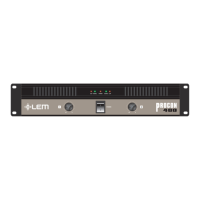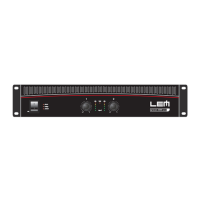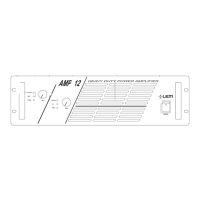o o
o o
o
44
44
4
(channel. A) or R17 (channel B) to obtain the same amplitude of the
scope signals.
➭
AMPLIFIER GAIN CHECKAMPLIFIER GAIN CHECK
AMPLIFIER GAIN CHECKAMPLIFIER GAIN CHECK
AMPLIFIER GAIN CHECK
Set CH2 scope at 50V/div. and connect it to the amplifier output of the
channel under test. By means of the SENSITIVITY switch check the
output levels: at 775mV position the output voltage must be 63±1.5Vp and
at 2.25V position must be 22.5±0.5Vp.
➭
AMPLIFIER BRIDGE MODE CHECKAMPLIFIER BRIDGE MODE CHECK
AMPLIFIER BRIDGE MODE CHECKAMPLIFIER BRIDGE MODE CHECK
AMPLIFIER BRIDGE MODE CHECK
Set the amplifier in BRIDGE mode (input signal to channel A), connect the
CH2 probe to the bridge output: the output voltage must be 124±3Vp.
➭
SIGNAL TO NOISE RATIO CHECKSIGNAL TO NOISE RATIO CHECK
SIGNAL TO NOISE RATIO CHECKSIGNAL TO NOISE RATIO CHECK
SIGNAL TO NOISE RATIO CHECK
Disconnect the audio generator and short the input (pin 1,2,3 of XLR
socket shorted) the output signal (noise) must be less 1mV.
AdvicesAdvices
AdvicesAdvices
Advices
➭ Check the channels one at time to determine which is right (note: if you
have a spare amplifier module that you know as right, use it).
➭ If the other channel doesn't work properly, you can replace the DRIVER
and POWER board one a time, using those of the right channel, to isolate
where is the damage.
➭ If you have determinate that the problem is a short on a rail, you must
check the output transistors. To do this you must remove before the
DRIVER board to access at the POWER board.
To determine which transistor devices are bad, use a soldering iron to lift
one leg of each emitter pin and measure the emitter-collector resistance
on each device. Unsolder and lift one leg of each base pin and check the
base-collector resistance of each transistor and replace any that measure
as a short.
If all the transistors are OK, unsolder and lift one leg of each diode and
check them.
Check the circuit board for open foil traces.
Use the Multimeter as Ohm-meter to check the resistors, particularly the
base and emitter resistors of damaged transistor.
➭ If the input sinewave appears to be distorted during the negative cycle,
you can assume that the problem is located somewhere in the circuitry of
the positive low rail.
If the positive cycle appears distorted, you can assume that the problem
is in the circuitry of the negative low rail.
➭ If the high rails appear distorted or are not modulating as shown in figure,
then the problem probably exists somewhere in the circuitry of the respec-
tive (+ or -) defective high rail. Refer to the schematics.
1KHz THD+N vs Input Level
SMPTE (%) vs Input Level
Common Mode Rejection Ratio
Frequency & Phase Response
THD+N (%) vs Freq. (8Ω load 3dB below clip)
Residual Noise vs Freq. (full power)
